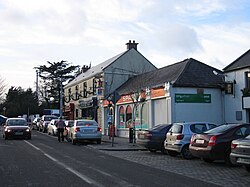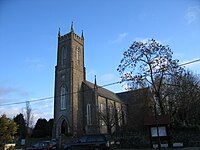Saggart
| Saggart Irish: Teach Sagard | |
| County Dublin | |
|---|---|
 Saggart village | |
| Location | |
| Grid reference: | O034266 |
| Location: | 53°16’48"N, 6°26’38"W |
| Data | |
| Population: | 3,133 (2016) |
| Local Government | |
| Council: | South Dublin |
| Dáil constituency: |
Dublin Mid-West |
Saggart is a village in County Dublin, to the south west of the City of Dublin. It is to be found between the N7 (the Naas Road), Rathcoole, and Tallaght. This is one of the fastest growing settlements in Ireland, showing a population increase of 46.1% between 2011 and 2016.[1]
Contents
Name
A monk called Mosacra founded a settlement on the site of the village in the 7th century. The name Saggart derives from Teach Sacra which means 'house of Sacra' in Irish. For many years Saggart was known as Tassagard or Tassagart, and the latter name persists in Tassagart House, and in the names of some housing estates in the area.
History
A monastery existed just outside the village in the 7th century. The remains of this monastery are found on the grounds of an equestrian centre about a mile from today's Saggart Village. After St Mosacra died, it became a nunnery with over 80 nuns living there until the Viking attacks of the 9th century.
By 1207, Saggart, or Tasagart, as it was then called by the Normans, had been made a prebend of the Cathedral of St. Patrick. In 1615, the church was reported as being in good repair but fifteen years later the church is stated to have fallen down, and the Protestant parishioners attended Rathcoole church. The current church was built in 1847.
From 1888–1932, the Dublin to Blessington tram service stopped at Saggart.
Churches
- Roman Catholic: Church of the Nativity of the Blessed Virgin Mary
About the village
Saggart is a heritage village. It is also home to the Citywest Hotel, which hosts many annual events including the Irish Masters (snooker) award ceremonies, and political ard fheiseanna. Citywest Business Campus is located just to the north of Saggart village and is home to many companies. The Citywest Shopping Centre, anchored by Dunnes Stores, is the only shopping centre in the area, and also has a pharmacy, two cafes and a range of other eating places. There is also a service / petrol stations, restaurants and a 4,000 seat convention centre at Citywest. The Citywest Business Campus also includes a Dublin City University facility. Jacob's Bar was established as a public house in the village by members of the Jacob family in 1901.[2]
Ancient artefacts
Some well-known objects of archaeological interest can be found in Saggart:
- A pair of megalithic standing stones in Boherboy, that are known locally as Adam and Eve.[3]
- The Raheen Standing Stone – a megalithic standing stone in a field on the Blessington Road, near Crooksling.[4]
- A 1939 excavation at Lugg uncovered the remains of what is thought to be a burial site that dates from the Bronze Age.[5]
There are four surviving pre-Norman monuments in the village:
- Two high crosses
- A cross-slab
- a cross-base
All of these monuments stand in the graveyard, sited across Garter Lane from the Roman Catholic Church. The graveyard predates the current church and is located on the site of previous church buildings, although believed to be the monastery of St Mosacra, the actual site is a mile away. The first edition Ordnance Survey map from 1843 shows the graveyard to be oval in shape, with access provided by a lane leading directly from the village; prior to this, the area is recorded by mapmakers as the site of a ruined church. Within the graveyard, there is a noteworthy memorial to Dublin merchant Edward Byrne, who was a member of the Catholic Committee, which included Wolfe Tone, which petitioned King George II in 1793 on behalf of the Irish people.
Nature
Saggart lies at the northern end of a mountain valley, the Slade of Saggart, with Brittas at the other side. The River Camac flows through this valley, passing around the village on the way to meet the River Liffey by Heuston Station.
The great spotted woodpecker, Ireland's newest breeding bird, has been seen here.
Sport
- Gaelic Athletics: St Marys GAA, founded in 1906.
Coolmine Equestrian Centre was established here in 1989. Within the equestrian centre's grounds are the remains of the 7th-century monastery of St Mo Sacra. The centre and CEAD-Ireland host equestrian activities and competitions and CEAD-Fest during the summer months.
Outside links
| ("Wikimedia Commons" has material about Saggart) |
References
- ↑ "All Towns (Ireland): Counties & Towns - Population Statistics, Charts and Map" (in en). https://www.citypopulation.de/php/ireland.php.
- ↑ Jacob's Bar
- ↑ Boherboy Megalithicireland.com
- ↑ Raheen Megalithicireland.com
- ↑ Saggart - History at SouthDublinHistory.ie
